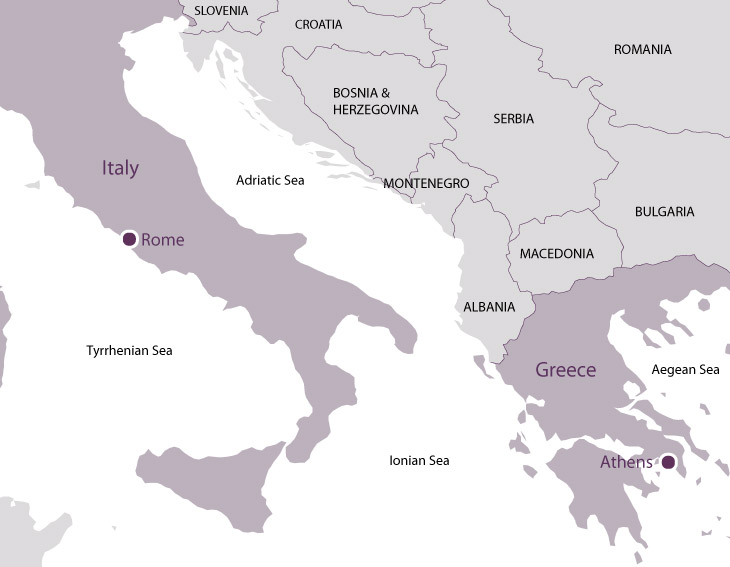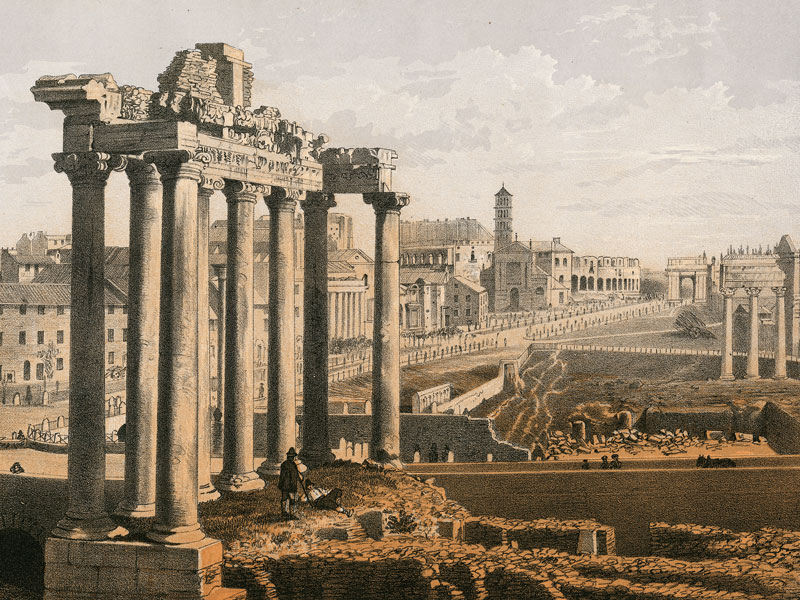Overview
The civilizations of ancient Greece and Rome had an enormous impact on the shaping of modern Europe: this tour will focus on two key sites that remarkably preserve outstanding ancient remains that enable us still to appreciate today both the astonishing sophistication of ancient Greece and Rome and our continuing debt to them today.
Athens has been the ‘capital’ of Greece only since 1834. In the fifth century BC this city enjoyed under the enlightened leadership of Pericles a cultural flourishing of incredible intensity, extraordinary versatility, superlative skill and remarkable originality. We will be looking in detail at three iconic fifth-century bc buildings on the Athenian acropolis, the Propylaea, the Parthenon and the Erechtheum, asking ourselves what makes these buildings so very special and why their impact has been so profound. Visits to the museum of the Athenian Acropolis and to the National Museum will enable us to appreciate the full gamut of Greek visual culture from its beginnings in the tenth century bc down into the Roman period. We will also visit the Theatre of Dionysus and in the Athenian marketplace (the Agora) we will be visiting the very birthplace of democracy, and seeing in its museum in the reconstructed Stoa of Attalus precious archaeological documents of that democracy in action.
Rome, by contrast, from humble origins, grew to be a capital city of a million inhabitants at the centre of a far-flung empire. It too was blessed by architects and artists of genius, and inside another iconic building, the Pantheon, we will see how radically different from the Greek was the Roman approach to building, with an emphasis on an architecture of interior space and on the use of new materials. In the Forum Romanum and nearby we shall see monuments associated with some of the greatest figures of Roman history, such as Julius Caesar, Augustus and Constantine, while our visits to the emperors’ palace on the Palatine and Hadrian’s self-indulgent rural retreat in the countryside near Tivoli provide a glimpse of the luxurious lifestyles of the imperial family itself. The tour concludes with a visit to Rome’s harbour town of Ostia near the mouth of the Tiber, which better than anywhere else allows us to imagine what an entire Roman town in central Italy would have looked like in the second and third centuries AD.
Day 1
Fly at c. 12.45pm (British Airways) from London Heathrow to Athens, where three nights are spent.
Day 2
Athens. The Acropolis is the foremost site of Classical Greece. The Parthenon (built 447–438 BC) is indubitably the supreme achievement of Greek architecture. Other architectural masterpieces are the Propylaia (monumental gateway), Temple of Athena Nike and the Erechtheion. At the Theatre of Dionysos plays by Aeschylus, Sophocles and Euripides were first performed. The new Acropolis museum has superb Archaic and Classical sculpture, including some by Phidias and his assistants.
Day 3
Athens. The Agora (market place) was the centre of civic life in ancient Athens, with the small Doric Hephaisteion, the best-preserved of Greek temples. The refurbished National Archaeological Museum has the finest collection of Greek art and artefacts to be found anywhere. The vast Corinthian Temple of Olympian Zeus was completed by Hadrian 700 years after its inception.
Day 4
Athens to Rome. Drive to the 5th-century Temple of Poseidon at Sounion, overlooking the sea at the southernmost tip of the Attic peninsula, visited by Byron in 1810. Fly at c. 3.30pm from Athens to Rome (Aegean Airlines), where four nights are spent.
Day 5
Rome. Visit the Colosseum, the largest of ancient amphitheatres, and the Arch of Constantine, sculpturally the richest of triumphal arches. The Palatine Hill was the site of the luxurious palaces of successive emperors. In the afternoon visit the Capitoline Museums, which have important collections of ancient sculpture, and see the Pantheon, the most complete of Roman buildings to survive.
Day 6
Tivoli, Rome. Drive to Tivoli to see Hadrian’s Villa, designed entirely by him and inspired by sites he visited during his travels in the Empire, undoubtedly the largest and most lavish Roman country retreat anywhere in the Roman Empire. Lunch is in a good restaurant. In the afternoon, see the awesome bulk of the ruins of the Baths of Caracalla, the best preserved of the several bath complexes that Roman emperors constructed in Rome for the enjoyment of the Roman people.
Day 7
Rome. Morning visit to the church of Santa Maria degli Angeli, built on the site of the Baths of Diocletian. Palazzo Massimo, home to the majority of the National Roman Museum’s collection, contains wonderful Roman frescoes and stuccoes. In the afternoon, visit the Forum Romanum, the civic, religious and social centre of Ancient Rome, which has the remains of many structures famed throughout the Empire.
Day 8
Ostia. Drive to Ostia, the ancient port of Rome, comparable to Pompeii for its state of preservation. Fly from Rome Fiumicino to London Heathrow, arriving at c. 7.00pm.
Price
£3,070. Single supplement £490 (double room for single occupancy). Price without flights £2,890 (this is the price without flights to and from London, but includes the flight on Day 4 between Athens and Rome). Included meals: 2 lunches, 6 dinners with wine.
Accommodation
Electra Palace Hotel, Athens: a smart hotel near the picturesque Plaka quarter. Hotel Bernini Bristol, Rome: a 5-star hotel excellently located on the Piazza Barberini.
How strenuous?
There is unavoidably a lot of walking, some of it over rough ground on archaeological sites, and there is quite a lot of standing in museums and archaeological sites. The historic areas of both cities are vast, and vehicular access is increasingly restricted. Minibuses or a coach are used on some occasions but otherwise the cities are traversed on foot. The tour should not be attempted by anyone who has difficulty with everyday walking and stair-climbing. Fitness is essential. Average distance by coach per day: 26 miles.
Are you fit enough to join the tour?
Group size
Between 10 and 22 participants.
Travel advice
Before booking, please refer to the FCDO website to ensure you are happy with the travel advice for the destination(s) you are visiting.

